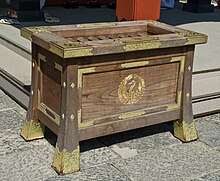Saisen
Appearance
move to sidebar
hide

A saisenbako
In Japanese, saisen (賽銭) is money offered to the gods or bodhisattvas. Commonly this money is put in a saisen box (賽銭箱, saisen-bako), a common item at Shinto shrines and Buddhist temples in Japan.
Used to collect offerings, a saisen box is typically a wooden coin box, with a grate for the top cover. This design allows coins to be tossed in, while still preventing the money from being retrieved easily. Some have grates made of round bars, or have borders that slope downward, allowing the money to slide into the box easily.
The amount of money offered is usually small, often in coin format. Five yen coins are a popular offering at saisen boxes due to the pun between five yen, go-en (五円), and the concept of an unseen connection between humans who know each other, go-en (御縁).
Saisen boxes always have locks, but recently thefts of saisen are on the rise. Some shrine priests have caught thieves in the act, while others take preventive measures by adding covers to the saisen boxes.
References
- ^ "Saisen: Basic Terms of Shinto". 國學院大學デジタルミュージアム (in Japanese).
- ^ 新井, 俊邦. "「賽銭泥棒を捕まえました」深夜2時に警察から電話が…被害にあった神主が明かす"現行犯逮捕"の一部始終". 文春オンライン.
Citations
- Iwanami Kōjien (広辞苑) Japanese dictionary, 6th Edition (2008), DVD version
See also
 | This money or currency-related article is a stub. You can help Wikipedia by expanding it. |

 A saisenbako
A saisenbako